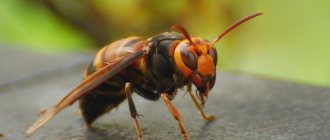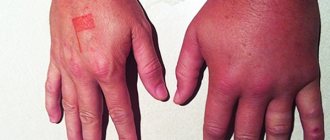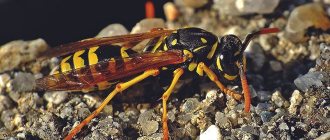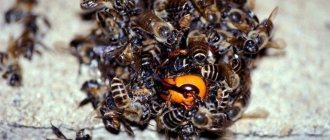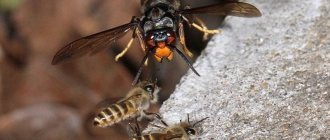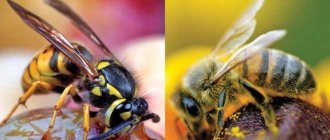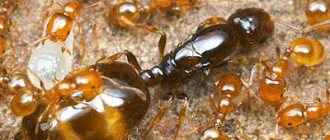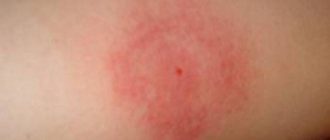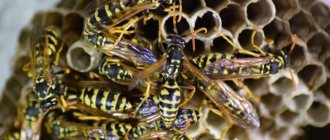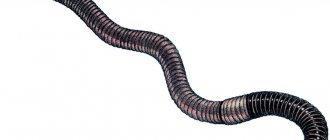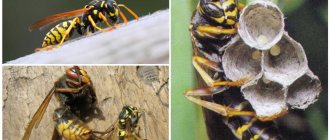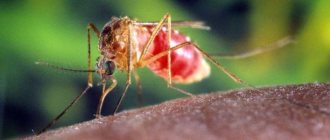- Wild animals
- >>
- Insects
We are surrounded by many interesting insects, among which the hornet .
These creatures have a very bright appearance, are quite large in size, and are excellent hunters of small pests. People don't hold hornets in high esteem. This is not surprising, because they can sting painfully, and their poison in large quantities can even lead to death. However, animals pose a great danger only in exceptional cases; a lethal dose can only be obtained with multiple bites. Otherwise, the hornet is a very interesting, useful insect. It's worth learning more about him!
Origin of the species and description
Photo: Hornet
A large wasp whose flight is accompanied by a loud buzzing sound is a hornet. It is a prominent representative of the family of social wasps, often called the hornet wasp. In Latin, the name of the species sounds like “Vespa”. It is translated into Russian by the word “wasp”. Initially, all social wasps were classified in the genus Vespa. However, in the nineteenth century it was divided into two families. Hornets are still Vespa and wasps are still Vespula (little wasp).
Video: Hornet
The origin of the Russian name “hornet” is no less interesting. The root of this word, in turn, means head, horns. For this reason, scientists concluded that the hornet wasp received its name due to the anatomical features of the structure of the head. The animal has an enlarged crown and movable antennae.
To date, about twenty species of hornet wasps have been recorded. Vespa mandarinia is recognized as the largest species. Adult Vespa mandarinia can reach five and a half centimeters in length.
Among the various types of hornets, we can separately highlight the most interesting of them:
- black hornet. This is a little-known, rare species of social wasp. Listed in the Red Book due to rapid decline in population numbers. It has the characteristic color of a predator - yellow stripes on a black back;
- Asiatic. Quite a large species with a large wingspan. Lives in Asian territory. It carries a certain danger for humans. Its bite is highly toxic;
- Philippine. It is distinguished by its solid black color and produces dangerous poison. Lives exclusively in the Philippine Islands;
- Oriental. Of all the representatives of the genus, it has the brightest colors. Its belly is decorated with a wide yellow stripe, its body and wings are painted bright red. The species tolerates heat remarkably well and lives in steppes and even deserts.
Potential danger from hornets to humans
Hornet on hand
People know that hornets can bite, but the risk of insect venom is often exaggerated. The poison is dangerous and causes allergies, so it is important to consult a doctor promptly. The reaction to poison can be different, as it depends on the person’s immunity. Bites can lead to swelling, fever, severe headache, heart palpitations, anaphylactic shock and even death. However, in cases where people do not pose a danger to insects, aggressive behavior can be avoided.
It is important to know the life cycle features and where hornets live in order to correctly assess the risk and successfully coexist with insects, ensuring safety for yourself.
Appearance and features
Photo: Hornet insect
The average size of these insects is from 1.8 to 3.5 centimeters. Only some species can reach a length of five and a half centimeters. Hornets are different from other members of their family. They have larger dimensions, increased head sizes, and a wide crown. These insects have compound and simple eyes. The color of the head depends on the type of hornet. It can be orange, red with a brown tint, black, yellow.
Adult individuals are distinguished by rather large, strong mandibles. They are colored yellow, brown or black. The insect's head has brown-black antennae. Their number depends on gender. The abdomen of such a wasp is round, with a clearly defined waist. There is a sting at the end of the belly. The sting, if the hornet is calm, is almost invisible. It is pulled into the body. At the beginning of the sting there is a special reservoir. It contains poison.
Hornet wasps have the ability to sting repeatedly. Their sting is smooth and straight. It does not have serrations, unlike the bee one. For this reason, when stung, the animal does not harm itself.
The body color of this type of wasp is similar to others - in most hornets it is black and yellow. The only difference is that the stripes alternate less clearly. However, there are varieties whose color is completely different from their relatives. For example, the variable hornet has a body with black and brown stripes.
Some hornet wasps have a fairly wide yellow or white stripe on their belly. The entire body is covered with small hairs. They grow chaotically and have different sizes. Hornets have three pairs of legs. They are either brown or yellow.
General information about hornets
Hornet is an insect related to wasps. The genus of hornets is classified as a widespread family of true (paper, social) wasps, among which its representatives are the largest (up to 5.5 cm in length).
In Latin, the genus of hornets is called Vespa, which means “wasp”.
The hornets' habitat is mainly in the Northern Hemisphere (Europe, Asia, North America, North Africa).
Table: classification of hornets
| Kingdom | Animals |
| Type | Arthropods |
| Class | Insects |
| Squad | Hymenoptera |
| Family | Real wasps |
| Genus | Hornets |
Structure and description
The average size of a hornet is 180–350 millimeters in length. The head is black, yellow, orange or red-brown - often the insect is distinguished by its reddish tint. The jaws are black, brown or orange-yellow. The coloring of the body, as a rule, is similar to that of a wasp - alternating black and yellow or reddish stripes, but usually they are not so contrasting. There are exceptions, for example, the variable hornet, painted exclusively in dark colors.
In general, the structure of the hornet is similar to the structure of other wasps:
- the body is divided into head, chest and abdomen;
- on the head there are two compound and three simple eyes;
The complex compound eyes of a hornet resemble sunglasses - there are two pairs of wings;
- the place where the chest meets the abdomen is narrow (“wasp waist”);
- at the posterior end of the abdomen there is an ovipositor (also known as a sting), which is retracted in a calm state.
The ovipositor of hornets, like that of other wasps, is smooth. Therefore, they can sting several times, unlike bees, which cannot get the barbed stinger back.
In addition to their size, hornets differ from other wasps in their wider crown (the part of the head located behind the eyes). In addition, their abdomen is rounded at the front.
Features of the life of a hornet
Hornets have a complex social organization with its own hierarchy. Insects of one colony (from several hundred to several thousand individuals) are divided into castes:
- queen - lays eggs, lives, as a rule, a year, but maybe more if it survives the winter;
- males - fertilize the uterus, live for several weeks - quickly die after fertilization;
- female workers - build a nest, get food, live for about a month.
Photo gallery: common hornets from different castes
The queen hornet is larger than all other individuals
Most of the workers are in the nest
Males are smaller in size
Reproduction
Working females are infertile because the queen secretes special pheromones that block the ability of “rivals” to reproduce. But around the beginning of autumn, the queen hornet lays eggs, from which females will emerge capable of bearing offspring. Males also appear at the end of summer. They mate with future queens. With the onset of cold weather, the hive dies, only fertilized females remain alive, looking for shelter for the winter. In the spring, the young queen chooses a place for a new colony, where she begins to build honeycombs.
Hornet development cycle:
- Each cell of the honeycomb built by the queen will contain an egg.
A new generation of workers will emerge from the eggs laid by the queen. - After about a week, larvae 1–2 mm in size will emerge from the eggs.
- After two weeks, the larvae become pupae.
- After another 14 days, an adult emerges from the pupa - a working hornet.
Nests
Hornets' homes are multi-tiered (up to 500 tiers). Insects hang nests in hollows, abandoned birdhouses, dry bushes, in attics and under the roofs of houses, in caves and simply on tree branches. Hornets' houses are large - they can reach 70 cm in height and exceed 40 cm in width.
Like their wasp relatives, hornets hang their nests at heights
The material used to build nests and the method of its production resembles paper. Hornets chew bark or wood well, adding their sticky saliva to it. The nest is built from the layers of the resulting mass. When the material dries, it becomes very similar to wrapping paper.
Hornets' nests look like they're made of paper
Some species of hornets build underground nests. And there are also those that take over other people’s nests, killing the host queen.
Nutrition
Hornets are omnivores. Adults consume plant foods and are especially fond of sweets: fruits, honey, nectar. They hunt various insects: flies, grasshoppers, caterpillars, wasps, aphids, ticks and others. They feed their larvae with animal food, after grinding it with their jaws to a liquid state. Dead insects, as well as human food waste (meat, fish), can be used to feed offspring.
Hornets sleep very rarely and work even at night.
Where does the hornet live?
Photo: Asian hornet
Representatives of this genus are widespread in the Northern Hemisphere. Their habitat depends entirely on the characteristics of the species. So, the most popular is the common hornet. This is the only species that lives in large numbers in Ukraine, Russia, and North America. In Russia, this wasp is represented more in the European part of the territory. You won't find it in the far north. The common hornet also lives in Japan, Korea, and China. Small populations of the animal can be found in Mongolia and Kazakhstan.
North America is not the natural habitat of the common hornet. The insect was brought there quite by accident back in the nineteenth century.
The Asian hornet lives in most of the territory of Asia, in the Jewish Autonomous Region, in the Primorsky and Khabarovsk Territories. It is large in size; in Japan this insect is called the “sparrow bee”. Also in tropical Asia, as in France and Spain, Asian predatory wasps are common. They build their “houses” on tree branches, feed and hunt bees.
The eastern hornet wasp chooses semi-dry subtropical areas for living. It can be found in Uzbekistan, Afghanistan, Turkey, Italy, Romania, Greece, North Africa, and other European and Asian regions. On the vast territory of the Russian Federation, scientists have noticed eight species of hornets. The common oriental hornet lives in the European part of the country. The other six species of insects live in the south of the Far East.
Hornet - photo
0
0
0
0
0
0
0
A couple of years ago we had a real boom - hornets were found literally at every step and in very large quantities. Especially in the evenings - crowds flew towards the light turned on in the garden. In subsequent years there were much fewer of them - and we again stopped noticing them. Have you ever had to deal with these insects? Share your experience in the comments!
What does a hornet eat?
Photo: Hornet in flight
The hornet is an amazing creature. It is capable of feeding on both plant and animal matter. In most varieties of such wasps, the diet consists of products familiar to the family: nectar, plant foods with a high sugar content. They are often spotted on rotting fruit, near honey, and on trees with sap flowing from the bark. Hornets constantly fly into orchards. There they feast on sweet overripe fruits. It is at this moment that the animal can sting a person who is reaching for the fruit.
Despite the fact that sweet nectar, fruits, and plant foods can completely satisfy the needs of the hornets’ body, these insects can instantly turn into excellent hunters. They kill other small insects with the help of powerful jaws and stings. Their victims include locusts, other types of wasps, bees, grasshoppers, butterflies, and spiders. Predatory varieties of hornets are capable of destroying about five hundred colonies of bees and wasps in their lifetime.
The most surprising fact is that the hornets themselves rarely consume killed insects for their own food. The animal thoroughly chews its prey until it becomes a uniform suspension. Adults bring this suspension to the nests and give it to the voracious larvae. Considering that the larvae eat small pests, the hornet can be called a beneficial insect.
Hornets and bees
Hornets are omnivorous in nature. They feed mostly on the sweet pulp of various fruits, but they are also predators. These giant wasps feed their larvae with caught and killed insects, while the adults themselves are not averse to snacking on a caught beetle or bee.
To a greater extent, these are very useful creatures for humans. A colony of these striped hunters that settles next to a gardener’s home can protect the crop from most harmful insects. Hornets are at the top of the invertebrate food chain and can bring half a kilogram of live food per day to feed themselves and their larvae.
Uneven fight.
But in an apiary environment, the benefit of these predators ends. Hornets are a real beekeeper's scourge. The bee and the hornet are the prey and the hunter. Hornets and bees are long-standing and primordial enemies, because one of the main hunting objects for this giant wasp is the honey worker. Fed on killed bees (and wasps as well), their larvae receive all the necessary nutrients they need for development.
Bees are practically defenseless against hornets. If a scout wasp notices the presence of a bee hive on the territory, without protective measures on the part of the beekeeper, the hive is doomed. Even one huge hornet can destroy dozens of bees, crushing them with its jaws and using a deadly sting.
The main goal of a hornet invasion of a hive is not the bees themselves, but the honey. The sweet substance is a real wealth for wasps; it can feed the entire colony in abundance.
Bees have only one effective method to deal with one hornet. By attacking a wasp in a swarm and enclosing it in a continuous living vibrating “cocoon,” the bees can kill the enemy by creating overheating conditions for him inside this trap, created from the bees themselves, constantly moving around the wasp.
Features of character and lifestyle
Photo: Hornet Red Book
Hornet wasps lead a social lifestyle. They gather in flocks and build nests. The number of one flock can reach hundreds of individuals. Hornet nests are distinguished by their special elegance and grace. These insects are one of the best builders. The founder of the nest is always the female that has survived the winter. With the onset of warmth, the female begins to search for a suitable place. Usually this place becomes an abandoned hollow in a tree, the attic of a residential building, or a crack in the rock.
The female begins building a nest from rotting wood and old bark. In this nest she establishes her colony. The first offspring of the female become worker wasps. They take over all responsibilities for construction, protecting the house, and feeding the offspring. Working hornets spend the whole day searching for food: nectar, plants, small insects. The lifestyle of hornets is predominantly diurnal.
These insects have a fairly high level of development. All representatives of the genus are able to distinguish each other's status. They do this by smell and other characteristics of adults.
The character of hornets is not warlike, they are not annoying. They will not climb into a jar of jam, and will not bother you with their presence near a feast with sweets and fruits. Hornets prefer to avoid the company of people, although they often build their nests in the attics of residential buildings. Despite this, hornet attacks on people are not that rare. And such a bite may not always go unnoticed. Severe allergic reactions occur. This is due to the high proportion of histamine in the venom of these insects.
Lifestyle
Like almost all Hymenoptera, hornets are collective insects. They live in large colonies in self-built cellular structures. Just like wasps and bees, only in smaller numbers. The hornets' nest is also larger in size than the wasps' nest.
Typically, these large wasps prefer to use hollow trees, attics of houses, occupied beehives, as well as animal holes and caves as shelters for their homes.
These wasps build their homes in several tiers, horizontally. The material for construction is chewed pieces of wood bark, most often birch, moistened with saliva. Therefore, such papyrus material is not white, but rather a brownish tint, while to the touch it resembles thin paper, something like paper foil, so to speak.
In created nests, hornets maintain a strict hierarchical system of relationships. At the head of the colony is the queen, which produces hundreds of eggs. She is protected by the rest of the family. All actions of its members are aimed at preserving the queen, and therefore the colony itself.
Each insect is like a cog in the system. Workers spend all their active time searching for food for the queen and the younger generation in the form of larvae. Among them there are also “cleaners” who perform the functions of “nannies” for the larvae and also clean the nest.
In fact, during the day, only the female, larvae and a number of workers and “nurses” are in the nest to maintain the colony’s defenses. The rest of the family visits the nest only at night to sleep. The hornets' nest is somewhat reminiscent of a feudal castle, with a queen, soldiers, artisans and servants. Just a little simplified.
Social structure and reproduction
Photo: Hornet
Hornet wasps are quite prolific insects. However, not all females are fertile. Uteruses are capable of reproducing offspring. They are usually large in size. It is the females who become the founders of the hornet family; they begin the construction of the house (nest). Before laying eggs, the queen, with the onset of the first heat, searches for a safe, convenient place to build a house. She lays eggs after building the first few hundred.
Further, her responsibilities include searching for food and caring for future offspring. It takes some time for the eggs to mature. First, larvae emerge from them, then adults. When new members of the community become like adult hornets, they take over all the responsibilities of their parent. The queen continues to lay eggs, and the worker wasps get food, guard the house, complete its construction, and care for the larvae.
After four weeks, new hornets emerge from the larvae. They usually kill the queen due to her inability to reproduce any more. Some individuals simply kick her out of the nest. Representatives of the genus living in the European part do not live long. Their total lifespan is only a few months. Only queens have a long life expectancy. They are able to spend the winter in suspended animation.
Hornets can give a good rebuff to their enemy as a whole flock. To protect themselves, they know how to quickly mobilize forces. In case of danger, this animal releases an alarm pheromone. If such a signal is noticed by his relatives, then the attacker faces real danger.
Reproduction
The founder of the colony is the most fertile female, which managed to survive the winter and give birth to the first offspring. In the spring, she herself lays the foundation of the future colony, building the first honeycombs for the future generation, and she herself feeds the larvae that emerge from the eggs.
The hornet larva looks like most other insect larvae. It has a white, slightly grayish color, a dark head, and the same dark longitudinal stripe, as well as a segmented body.
By mid-summer, the first larvae develop into adults, after which they take on all responsibilities for protecting and providing for the queen and nest. The uterus no longer works and is exclusively engaged in reproduction.
The colony grows quickly, and by autumn there are already representatives of all “classes” in it, including the “drones” that fertilize the queen. Closer to the cold weather, fertilized females look for shelter for the winter, so that next season they can give birth to a new generation and become queens in their own families. The remaining members of the colony die even before the cold weather, since they live no more than a few months. The uterus can live for a year.
Natural enemies of hornets
Photo: Hornet insect
Hornets don't have many natural enemies. This is due to the fact that these insects are relatively peaceful. They prefer to run away from the enemy. Only by defending itself can a hornet show itself as a real hunter. Such animals are especially ferocious if someone has coveted their nest, offspring, or uterus. Also, the small number of natural enemies is explained by the toxicity of hornet wasps, as evidenced by their bright color. Other animals try to avoid such insects.
Some of the natural enemies of hornets include:
- small parasites. Nematodes, parasites, and mites slowly but surely kill large hornets and greatly undermine their health;
- some types of birds. Only certain species of birds are able to hunt representatives of social wasps. Most birds simply swallow them whole, preventing the insect from stinging them;
- fungi. The fungus can grow in the hornet's head, leading to a painful and long death;
- other insects. Hornets can be killed by larger wasps and ants. Ants most often feast on insect larvae;
- of people. Despite the benefits they bring, hornets are considered pests. They settle in residential buildings, are quite dangerous to human health and life, and cause significant damage to young trees. For this reason, hornet nests are often destroyed by people.
Hornets collect material for construction from rotten stumps and birch branches.
0
The color of the building material is different from the color of materials of other members of the family, and the hornets’ nests look prettier, so to speak, not just a gray color, like ordinary wasps, but a real work of art, including color.
0
0
0
0
0
Population and species status
Photo: Hornet animal
The genus of hornets is quite wide. It includes more than twenty different species of insects, differing in color, size, feeding habits and lifestyle. Due to the presence of several species and high fertility, this genus is not endangered and is not listed in the Red Book.
The general population of hornets does not cause concern among scientists. It is normal, causes the least concern, and has a low risk of extinction. However, if we consider the hornet wasp population in terms of individual species, the situation is not so encouraging. Many species are on the verge of extinction and are listed in the Red Books of individual states and cities. The reduction in the number of such animals is due to completely different reasons, which can be found out in the next section of the publication.
The common hornet is an endangered species. Its population in different regions of its natural habitat is very unstable. In particular, this variety is included in the Red Book of the Smolensk region. Also a small representative of the hornet genus is the Dybovsky hornet (black). It is of average size for hornets, has a black-brown color, and is a predator. The black hornet is included in the Red Book of the Chita region. Some species of hornets are included in the Red Books of Germany and many other European countries.
Hornets nest
Hardworking insects are excellent architects. Their honeycombs are shaped like hexagons, and the nests themselves reach gigantic sizes - up to 70 cm in length. The construction of a house for the hornet family begins with a young queen. She uses the bark of ash and birch branches and rotten wood as material. By mixing them with saliva, the insect receives a material similar in properties to cardboard.
From the outside, the nest has a round shape; cells with eggs and larvae are hidden inside. Construction is carried out in tiers, their number reaches 6-7 pieces. The membrane protects the younger generation and the uterus from cold and drafts. The expansion of the home is carried out from top to bottom, by adding the next tier. One entrance is left for insects to enter the house. Working hornets develop in the upper tiers, and future queens develop in the lower ones. Larger honeycombs are created for them.
Benefits and harms
Hornets are useful in that they destroy insects, making it easier for gardeners to combat garden pests, but the hornets' usefulness ends when they settle in apiaries.
Hornets - a thunderstorm of bees
In autumn, honey bees become the main food of hornets - other insects already die at this time.
When raiding hives, one hornet can eat about 30 bees in a day.
When uninvited guests appear, beekeepers try to get rid of them by all possible means.
Being too close to hornets can also be dangerous for humans. An insect bite causes burning pain and can provoke severe allergic reactions.
The bite can be dangerous to humans
Consequences
When attacking, a hornet can bite one or more times. A single bite is not as dangerous to humans as multiple bites. Getting large amounts of insect venom under your skin can cause serious problems.
After a hornet attack, a person experiences body intoxication , which leads to the following consequences:
- dizziness, headache, signs of nausea and vomiting.
- fever and chills, sweating.
- difficulty breathing, shortness of breath, in rare cases, convulsions.
The consequences may vary in severity. It depends on the type of hornet, on the person’s immune system, on his age and sensitivity to allergens. Children are the most susceptible to hornet venom. The most dangerous consequence of a hornet attack can be Quincke's edema and anaphylactic shock.
Help with a bite
There are several first aid rules for a hornet sting that will help minimize the consequences of an attack by the largest wasp. The sequence of actions is as follows:
- Examine the bite site and remove sting particles with tweezers, if any.
- Carefully squeeze out the insect venom.
- Wash the wound with soap and then wipe it with a solution of alcohol or potassium permanganate.
- Apply cold.
- Take an antihistamine.
You don’t need to visit a doctor if the hornet has bitten you only once and there is no deterioration in the victim’s condition. However, you should consult a doctor if the following signs are present:
- severe pain and extensive swelling of the bite site;
- weakness and severe manifestations of allergies;
- attack by several hornets at the same time;
- The victim's age is under 16 years.
Burrowing wasps are very caring parents. Paper wasps are named so because of the way they build their nests. A complete description of the insect can be found here.
A road wasp sting can be quite dangerous, especially if a person has allergies. What to do if you are bitten, read the article at this link.
How to Avoid a Bite
The hornet attacks only when it senses danger to itself or its nest. At the first threat, it releases a special substance - alarm pheromone , which serves as an attack signal for other individuals. Therefore, you should not kill the hornet near the nest. Hornets,
sensing the smell of danger, the whole family can attack the offender of their relative.
It is advisable to destroy hornet nests only in cases where they threaten bees or their nests are located too close to housing. If the insects have built their home where they will not be disturbed, there is no need to be afraid of their attack. On the contrary, they will even become assistants in protecting the crop from other insects.
Of course, the hornet can be dangerous to humans. However, you can coexist peacefully with it, if you take into account its habits and characteristics. It is also better not to come close to it and not disturb its nest. And it is important to remember that in nature there is nothing superfluous, which means it is better to protect hornets rather than destroy them.
Dybovsky's Hornet
Dybovsky's Hornet
The second name of this species is “black hornet”. The coloring resembles a strange bee with a black belly and red-brown head and chest. There are no yellow spots on the body. It is rare because it leads a parasitic lifestyle. The female Dybowski hornet takes over the nests of smaller relatives, forcing workers to take care of her offspring. This species does not need a “family” to reproduce; queens and males are sufficient.
The bite is stronger than that of the European species, but weaker than that of the Asian species. The poison is intended only to kill insects, so the consequences for humans may differ from the reaction to the bite of other types of wasps.
On a note!
Another black hornet wasp, native to China, was introduced to France. Vespa velutina is not dangerous to beekeeping and is completely black in color. Only her paws and two thin stripes on her abdomen are yellow.
Hornets are social insects
People call them pirates. Other names are “winged corsairs”, “flying tigers”. This is what the biological classification of hornets looks like:
- class of insects (Insecta);
- order Hymenoptera (Hymenoptera);
- family of folded paper wasps (Vespidae).
The world has twenty-three types of hornets and many of their subspecies. In some European countries they are under state protection. So, for example, in Germany, a fine of 50 thousand euros is provided for the destruction of nests of such insects. The common hornet lives in numerous colonies or families, which include: females, males and workers. By the end of August – beginning of September, the number of colonies can reach 400–800 pieces.
There may be several females in a family, but there is only one hornet queen. At the same time, to prevent mating and the laying of fertilized eggs by other females, the main queen emits a special smell (Pheromone), and the secondary ones lay unfertilized ones, from which only drones hatch. Hornets settle in earthen nests, choose tree hollows, places under round roofs, and on fences for their homes. They make nests using saliva and chewing wood. The first spring generations consist of working hornets. Autumn - these are females and males. Only the fertile individuals remain for the winter. They hibernate.
The common hornet destroys its prey with a blow from its sting. Another way is to tear the victim apart with its jaws. Predators eat various insects, including nocturnal ones. The hornet kills a caught bee immediately and sucks it out. It carries the prey's breast to the nest to feed its brood.
During the day, a large family of winged predators catches up to 500 grams or more of insects. Hornets are very useful in the garden!
They feed on the juice of ripe fruits, trees and nectar of easily accessible flowers.
Protein food is necessary for the uterus for exhausting work - laying eggs. Hornets hardly sleep, they only freeze for half a minute about 20–25 times a night and do not move.
Lifestyle
The rules for the existence of hornets in nature are very similar to those of bees and ants. In order to survive during the cold winter and give birth to offspring every year, insects have to sacrifice someone and something. They sacrifice males, who die soon after mating. This way resources are not wasted on already “useless” individuals.
After all, in the hornet family, the females are the main ones. Therefore, they must prepare well for hibernation, survive it, and in the spring become the founder of a new colony. The uterus needs a large amount of protein to produce eggs and develop ovaries. In order to successfully overwinter, it eats very richly and accumulates a fat body.
Mating Features
The greatest activity in the hornet family is observed at the end of the warm period of the year, namely the end of August and the beginning of September. By this period, individuals of both sexes become adults. They all leave their home, swarm and mate. Thus, mating occurs before the onset of cold weather. Female hornets spend the winter pregnant.
Males die soon after mating. Females lead a solitary lifestyle. They feed heavily, and between meals they fly around the nearby territory in search of a safe place for winter shelter. Overwintering of a pregnant female hornet, which falls into suspended animation, is possible only in a secluded place where enemies and cold winds will not find her.
Wintering conditions
Crevices in rocks, tree hollows, shelters under stones and fallen trunks, and small cavities on the outside of unheated buildings or houses are well suited for this. There is no need to be afraid that the female will hide inside a human house. There's a good reason for this. When cold weather sets in, when the air temperature drops below 00 C, all water freezes.
But the water in the hornets does not freeze. This is due to the fact that in the body of insects, water is replaced by glycerol. It does not freeze, but it slows down all life processes. This way, the glycerin cannot turn into ice and rupture the insect cells. If the hornet warms up prematurely, it will die during the next cold snap.
When the female hides for the winter in a heated human house, the warm air temperature will contribute to her premature awakening and the natural need to build a nest. If she manages to hide in a house from human eyes, then it will be very difficult for her to look for material to build the honeycomb of her “house”.
When she manages to build a nest, she will not be able to find enough food in the house to feed her offspring. Thus, she will doom him to certain death. Therefore, female hornets do not choose heated human houses for wintering.
The main condition for successful wintering is constant air temperature without sharp fluctuations.
A lot of female hornets die during harsh winters with little snow, as well as in the presence of winter thaws. If the female does not manage to hide well, she will become prey to various birds or small predators. Therefore, a significant number of hornets do not survive until spring.
Spring chores
The female hornet wakes up when the air temperature warms up to +150 C. The awakened young pregnant insects begin to actively hunt so that the embryos can develop into full-fledged eggs. In addition, the young female is looking for a suitable place to build her nest.
Help with a bite.
Old females also wake up, but they do not look for a place to build a nest. They scatter around the surrounding area. When the first cold days arrive, they stop their activity and freeze. As a rule, they die before they reach their second wintering. After a nest site has been found, the young female builds the first comb and lays her eggs there.
Only worker hornets emerge from the first eggs. The female must raise them. Then they take the baton into their own hands. Working individuals independently complete the nest and feed the larvae from later eggs. Already from these larvae males and females will grow. They will begin a new cycle in August. The lifespan of worker insects is only three to four weeks.
If you meet a hornet in early spring, it is most likely a pregnant female busy with procreation. She doesn't specifically touch people, but she's not afraid of them either. The female is not dangerous to you. She has no time to threaten anyone, because she has many more important things to do. Don't touch her. Let her reproduce her offspring.
OUR READERS RECOMMEND!
To get rid of insects, our readers recommend the Pest-Reject repeller
. The operation of the device is based on the technology of electromagnetic pulses and ultrasonic waves! Absolutely safe, environmentally friendly product for humans and pets. Read more here...
